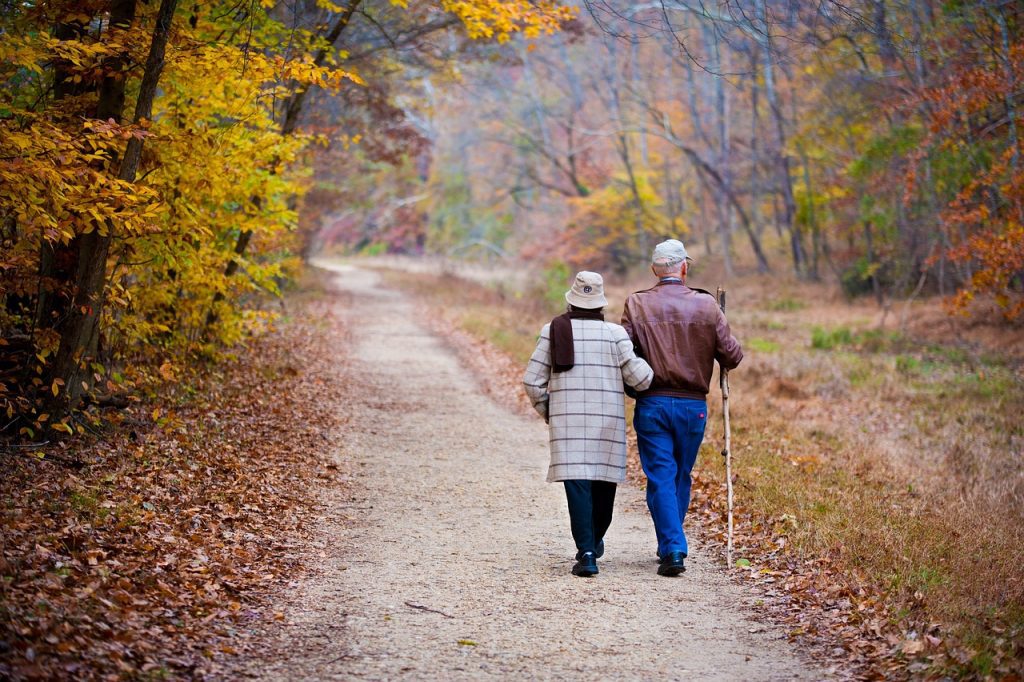As we age, it becomes increasingly important to stay active and maintain our physical and mental health. One simple and effective way to do this is by walking. Walking is a low-impact activity that can be done almost anywhere and at any time. This makes it an ideal exercise for anyone but especially for people in their 50s and beyond. Walking improves cardiovascular health and reduces the risk of chronic diseases. It also has numerous mental health benefits, such as reducing stress and anxiety and improving mood and cognitive function. In this blog post, we will explore the many benefits of walking in your 50s. We’ll also provide some tips for incorporating walking into your daily routine.
The Physical Benefits

Walking is an excellent form of exercise that can benefit people of all ages. However, it can be particularly beneficial for those in their 50s. Here are some physical benefits of walking in your 50s:
- Improves cardiovascular health: Walking is a great way to get your heart rate up and improve your cardiovascular health. Regular walking can help strengthen your heart, lower your resting heart rate, and improve blood flow throughout your body.
- Lowers blood pressure and cholesterol: Walking can help lower blood pressure and cholesterol levels. Both are risk factors for heart disease. By regularly walking, you can help keep your blood vessels healthy and reduce the risk of heart disease.
- Helps with weight management: Walking is a great way to burn calories and maintain a healthy weight. By walking regularly, you can help boost your metabolism, increase your energy levels, and manage your weight.
- Reduces risk of chronic diseases: Walking can help reduce the risk of chronic diseases, such as type 2 diabetes, osteoporosis, and certain types of cancer. Regular walking can help improve insulin sensitivity, strengthen bones, and boost the immune system.
- Strengthens bones and muscles: Walking is a weight-bearing exercise, which means it helps strengthen bones and muscles. This is particularly important for people in their 50s, who may be at risk for osteoporosis or other bone-related conditions.
- Increases flexibility and balance: Walking can help improve flexibility and balance. This can help reduce the risk of falls and injuries. By regularly walking, you can improve your posture, increase your range of motion, and improve your overall balance.
Overall, walking is a simple yet effective way to improve physical health in your 50s. Walking regularly can improve your cardiovascular health, lower your blood pressure and cholesterol, and manage your weight. It can also reduce the risk of chronic diseases, strengthen your bones and muscles, and increase your flexibility and balance.
The Mental Health Benefits

In addition to the physical benefits, walking also has numerous mental health benefits, particularly for people in their 50s. Here are some mental health benefits of walking:
- Reduces stress and anxiety: Walking can help reduce stress and anxiety by increasing the production of endorphins. Endorphins are the body’s natural mood boosters. Walking also helps to lower the levels of stress hormones like cortisol in the body. Cortisol contributes to feelings of stress and anxiety.
- Improves mood and overall well-being: Walking can help improve your overall well-being and boost your mood by increasing levels of serotonin and dopamine. Those particular hormones are neurotransmitters associated with happiness and pleasure. Regular walking can also help reduce feelings of depression and increase self-esteem.
- Boosts cognitive function and memory: Walking has been shown to improve cognitive function and memory. This is particularly important for people in their 50s as they may be experiencing age-related cognitive decline. Walking helps to increase blood flow to the brain, which can help improve cognitive function and memory.
- Helps with sleep quality: Walking can also help improve sleep quality. This is important for people in their 50s as they may be experiencing changes in their sleep patterns. Regular walking can help regulate the body’s sleep-wake cycle, making it easier to fall asleep and stay asleep throughout the night.
Overall, walking is a simple yet effective way to improve mental health in your 50s. By walking regularly, you can reduce stress and anxiety, improve your mood and overall well-being, boost cognitive function and memory, and improve sleep quality.
The Social Benefits

Walking not only provides physical and mental health benefits but also offers social benefits, which can be particularly important for people in their 50s. Here are some social benefits of walking:
- Provides opportunities for social interaction: Walking provides a great opportunity to socialise with friends, family, and even meet new people. Whether it’s joining a walking group, walking with neighbours, or simply going for a stroll with a friend, walking provides a low-key and enjoyable way to engage with others.
- Encourages outdoor activities with friends and family: Walking can encourage outdoor activities with friends and family, which can enhance the overall quality of life. Walking together in nature can provide a sense of connection and shared experience, and can create memories that last a lifetime.
- Enhances overall quality of life: Walking can enhance the overall quality of life by providing a sense of purpose and enjoyment. By regularly walking, individuals can experience increased energy levels, improved physical and mental health, and a greater sense of well-being.
Overall, walking is a simple yet effective way to improve social health in your 50s. By walking regularly, you can increase opportunities for social interaction, encourage outdoor activities with friends and family, and enhance overall quality of life.
Tips for Walking in Your 50s

Here are some tips for walking in your 50s:
- Choose the right shoes and clothing: Choose comfortable shoes with good arch support and a non-slip sole to reduce the risk of falls and injuries. Wear lightweight and breathable clothing that will keep you comfortable and cool while walking.
- Set realistic goals and increase intensity gradually: Start with small and achievable goals, such as walking for 10 minutes a day, and gradually increase the duration and intensity of your walks. This will help you avoid injury and build up your endurance over time.
- Incorporate walking into your daily routine: Try to make walking a part of your daily routine by scheduling it into your day. For example, you could take a walk during your lunch break or after dinner. This will help you establish a consistent walking routine and make it easier to stick to your goals.
- Stay safe while walking: Walk in well-lit areas, wear reflective clothing if walking at night, and carry a cell phone in case of emergencies. Be aware of your surroundings and avoid walking in areas with heavy traffic or uneven terrain. If you have any medical conditions, such as heart disease or diabetes, consult with your doctor before starting a walking program.
In summary, by choosing the right shoes and clothing, setting realistic goals and increasing intensity gradually, incorporating walking into your daily routine, and staying safe while walking, you can enjoy the many physical, mental, and social benefits of walking in your 50s.
Benefits of Walking in Your 50s
In conclusion, walking is an excellent form of exercise that offers a wide range of benefits for people in their 50s. From improving cardiovascular health and reducing the risk of chronic diseases to boosting mental health and providing opportunities for social interaction, walking is a simple and effective way to enhance overall well-being. By choosing the right shoes and clothing, setting realistic goals, incorporating walking into your daily routine, and staying safe while walking, you can experience the many benefits of walking in your 50s. So why not grab a pair of comfortable shoes and take a walk today? Your body, mind, and spirit will thank you for it!
Read More
- The Role of Genetics in Obesity: Myths and Realities
- How Maintaining a Healthy Mindset Improves Your Life
- 3 Surprising Sources of Protein, Fibre, and Essential Vitamins
- Self-Care Health: Why Taking Care of Yourself is So Important
- Adult Acne: Why It Happens and How to Treat It
Disclaimer: The information provided on Healthy Lifestyles for All is intended for general educational purposes only and should not be considered as medical advice. Please consult with your GP or other health professional before making any significant changes to your diet, exercise routine, or any other aspect of your lifestyle. We are not responsible for any adverse effects or consequences resulting from the use of the information provided on our blog.
Comments: I hope you enjoyed reading this post as much as I enjoyed writing it. If you liked it, please leave a comment. If you didn’t like it, disagree with something I have written (I’m okay with that), or think I got something wrong (that’s okay too), please leave a comment as well. We only truly learn from our mistakes, so I am happy to have mine pointed out.
Affiliate Links: Please also note that I may make a small amount of money if you buy one of the products I recommend in any of my blog posts. Rest assured that I have done my own due diligence, and only recommend products that have been tried and tested, and have extremely good feedback. Additionally, many of the products I recommend have 30 or 60-day money-back guarantees, so you can buy in the confidence that if a particular product is not right for you, you can get a refund.

